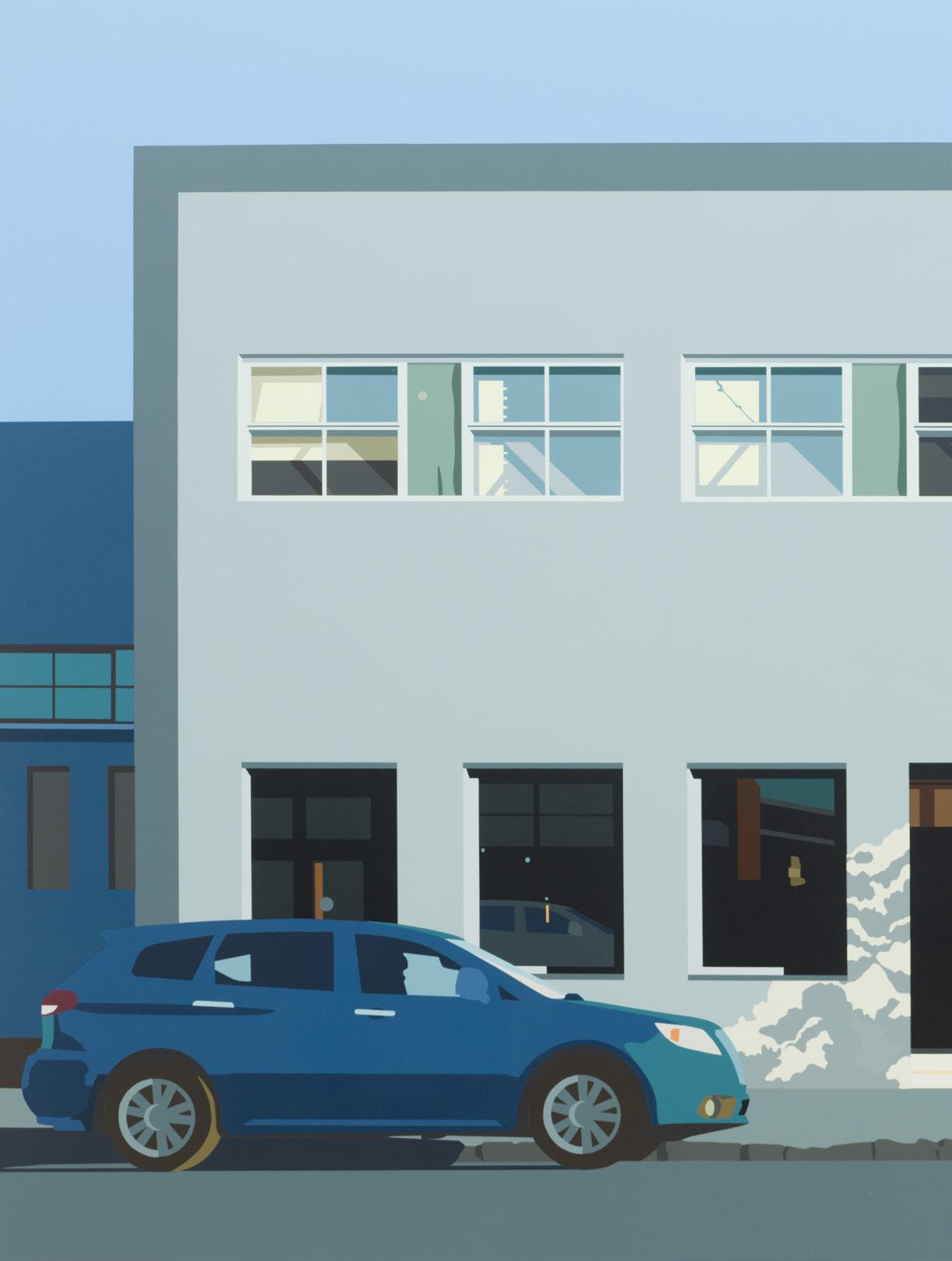
4 minute read
Joanna Lamb:Perceiving the Familiar
By Dr Kevin Robertson
Joanna Lamb’s paintings continually question the idea of the familiarity of the everyday things you see. The highly recognisable nature of the subject matter opens a dialogue with the audience which results in the viewer’s ongoing entanglement with the artist’s vision.

Joanna Lamb portrait. Photographer credit: Tanita Seton
Imagine that your car turns mistakenly into an unknown street, somewhere in a light industrial zone. You are late for an appointment, but instead of becoming stressed, you stop to look at the arrangements of the roller-doors, footpaths, coloured concrete render and lawns and notice the way the shapes of things are locking together. As you disappear into observation and become less anxious you realise that your thoughts are balanced by a sense of stillness, quietness and neutrality. This is where Lamb’s paintings come to mind as a comparative experience through your memory and how they affect the way you read these everyday scenes. Your mind flicks between the two things, her paintings and the street’s vista, comparing and then merging them.
Rather than assert the identity of the painter, her paintings assume the opposite position, that of an unseen author, and in this painter/viewer dyad, you interact with the painter. A similar thing occurs with painters like Edward Hopper, Jeffrey Smart or Clarice Beckett, whose works also deal with familiar imagery and provide a counterpoint to your perception of the familiar.

Joanna Lamb Industrial Streetscape 2, 2019 acrylic on board 156.5 x 126.5 cm
Lamb has worked steadily in Australia for several decades, producing fresh, crisp, images of urban centres and in particular of her home city, Perth. The shifts in her working methods are inventive and subtle. Sometimes the paintings exist directly on the wall itself rather than occupy the frame. At other times her paintings transform into collages or become tiled into fragments of Laminex. The paintings are matt acrylic and therefore without surface reflection. This reinforces the quiet and fixed quality, which is also gently asserted by the absence of brushstrokes. There is a strong continuity in the works – that reminds us we are always dealing with the same unseen author.
The artist is also, most often, invisible in an emotional sense. By avoiding a tactile technique, her work bypasses the ongoing romantic ideas of expression and the ego of the artist. Instead she retreats to her suburban studio, the antithesis of the inner-city loft. Lamb draws subjects from her surroundings, attracted to their obviousness and generic nature. A pigeon noticed on the ground, a view from a cave in a park, anything may become a subject. These things are seen by the artist as both nostalgic and current. They are then pocketed and taken back to the studio for analysis. There are no restrictions on her methods, digital media also assists in burying the identity of the artist. The sharply imaged outcome, held together with tonality is always the main game, unencumbered by painterly ideas of “touch” and “trace”. You, as a viewer, provide the missing subjective element and decide how these things affect you.
Lamb increases the acuity of her palette with every new painting. The colour mosaic in her work is continually refined. You see a blue shaded window frame, giving depth to a perfectly rendered sky reflection as in a recent work Apartments 012020, while the high pitch of tone in the ubiquitous orange tiled roof, recesses in space behind these elements. Her naturalism in colour is increasing to an astonishing degree and very few artists are even close to her in this respect presently, yet her work always remains a measured distance from realism.
As Australia now exists inside a perfect bubble, Lamb’s paintings could be seen as a metaphor for, or even a premonition of this. There are no people on the streets in these works. Occasionally figures are depicted as shapes in dense public spaces in her paintings, but not as distinct individuals, rather as mere accessories to the architecture.
In current times everyone is forced to look again at what is right in front of them, at their own streets, in their lounge rooms and on their walls, as much as they are dreaming of travel overseas or looking at screens. Lamb’s paintings reflect this close, localised scrutiny. Through her paintings, she carefully and slowly takes note of her experience. This close scrutiny sets in motion a process for the artist that results in the experience being transferred into a meticulously precise, 2D geometrical equivalent of it, rather than a direct, mimetic account.
At times though, there are evocations of emotion in her painting. A stark branch or an intense highlight on a car window is a reminder that pathetic fallacy is possibly just below the surface in her work, ready to break through the opacity of colour, disrupting the tight analytic structure of the compositions.

Joanna Lamb Streetscape, 2019 acrylic on board 94.5 x 125 cm
The cycle between detachment and then restricted emotional engagement with everyday landscape is ongoing in Lamb’s painting. The changes in the painter’s attitude to her subject from one painting to the next are micro-expressions and therefore difficult to detect. This air of control is what gives you the viewer, the space to make a comparison to your own sense of familiarity with these scenes, which often results in a feeling of balance. Lamb enables this exchange of experience, through things she has noted and recorded in these wonderful, intelligent, super-observed paintings.
Dr Kevin Robertson is an artist and a sessional academic at Curtin University, Perth

